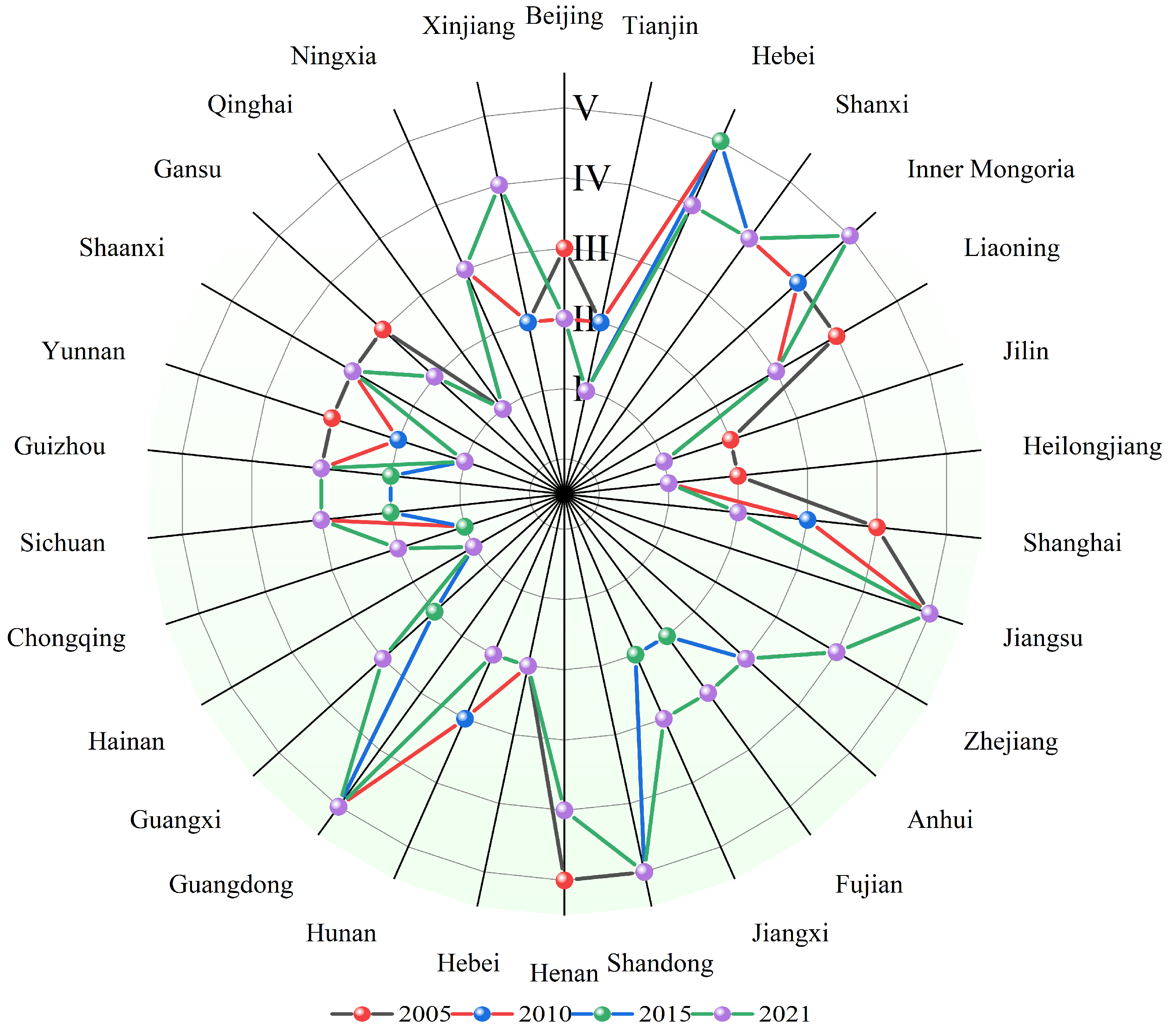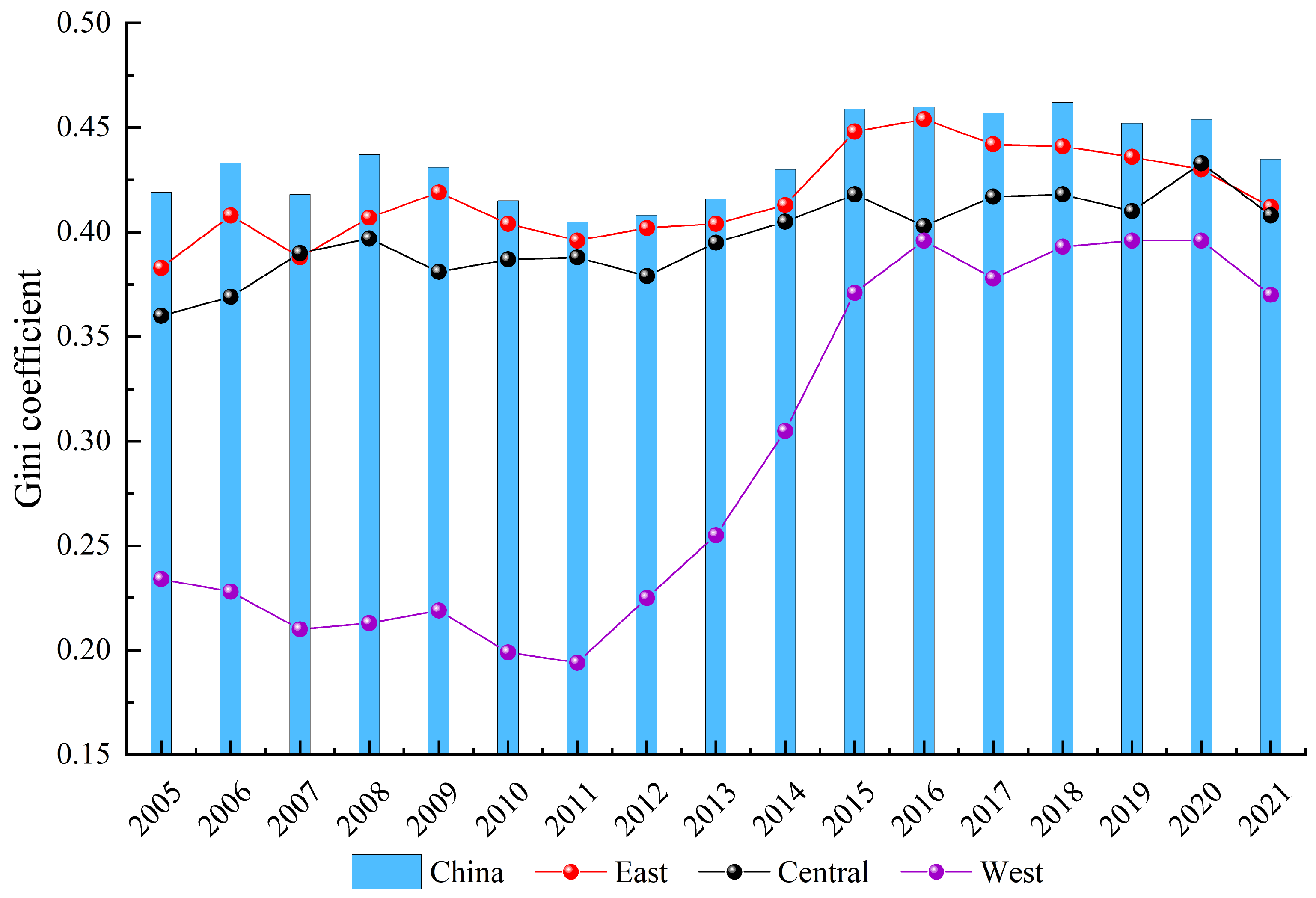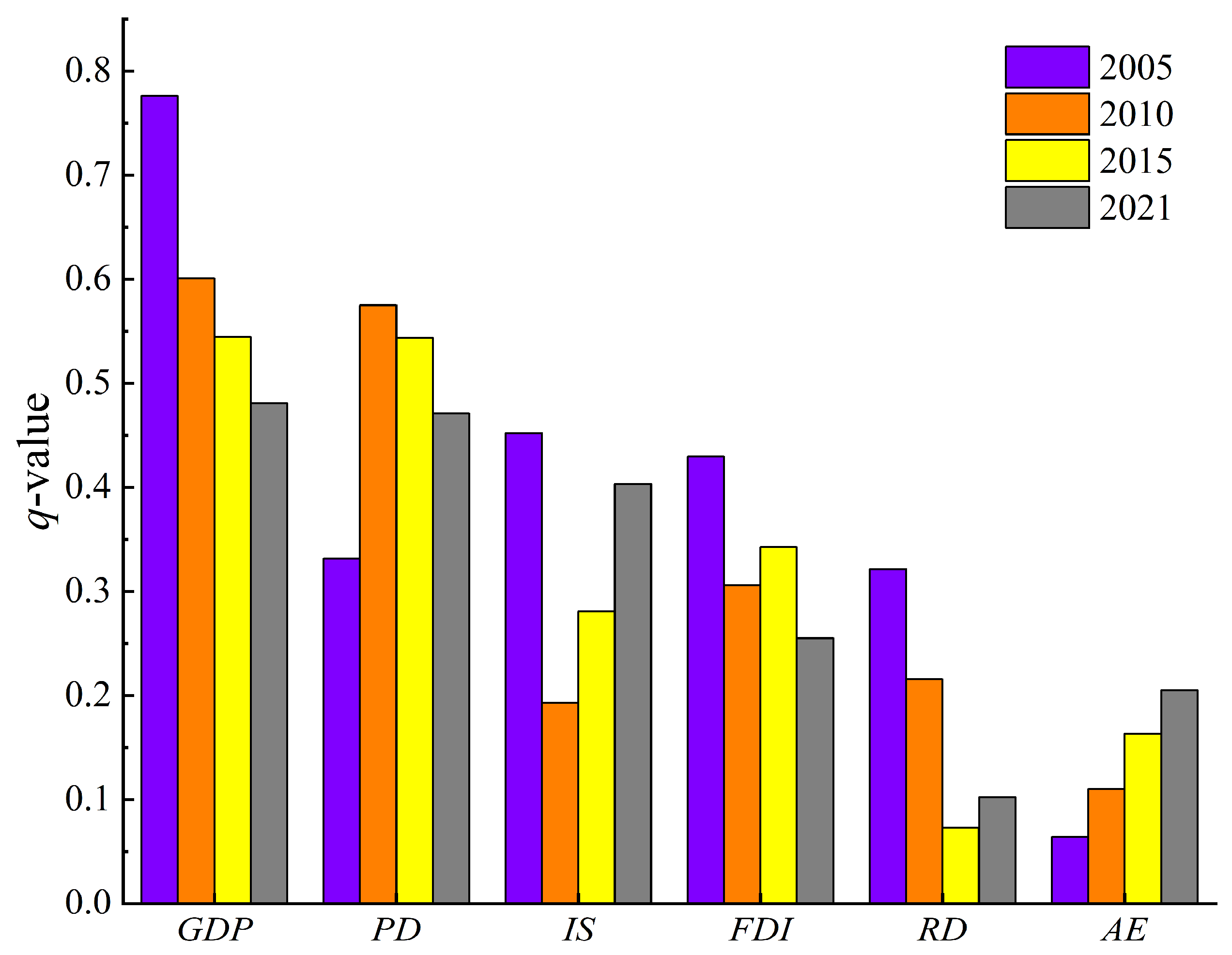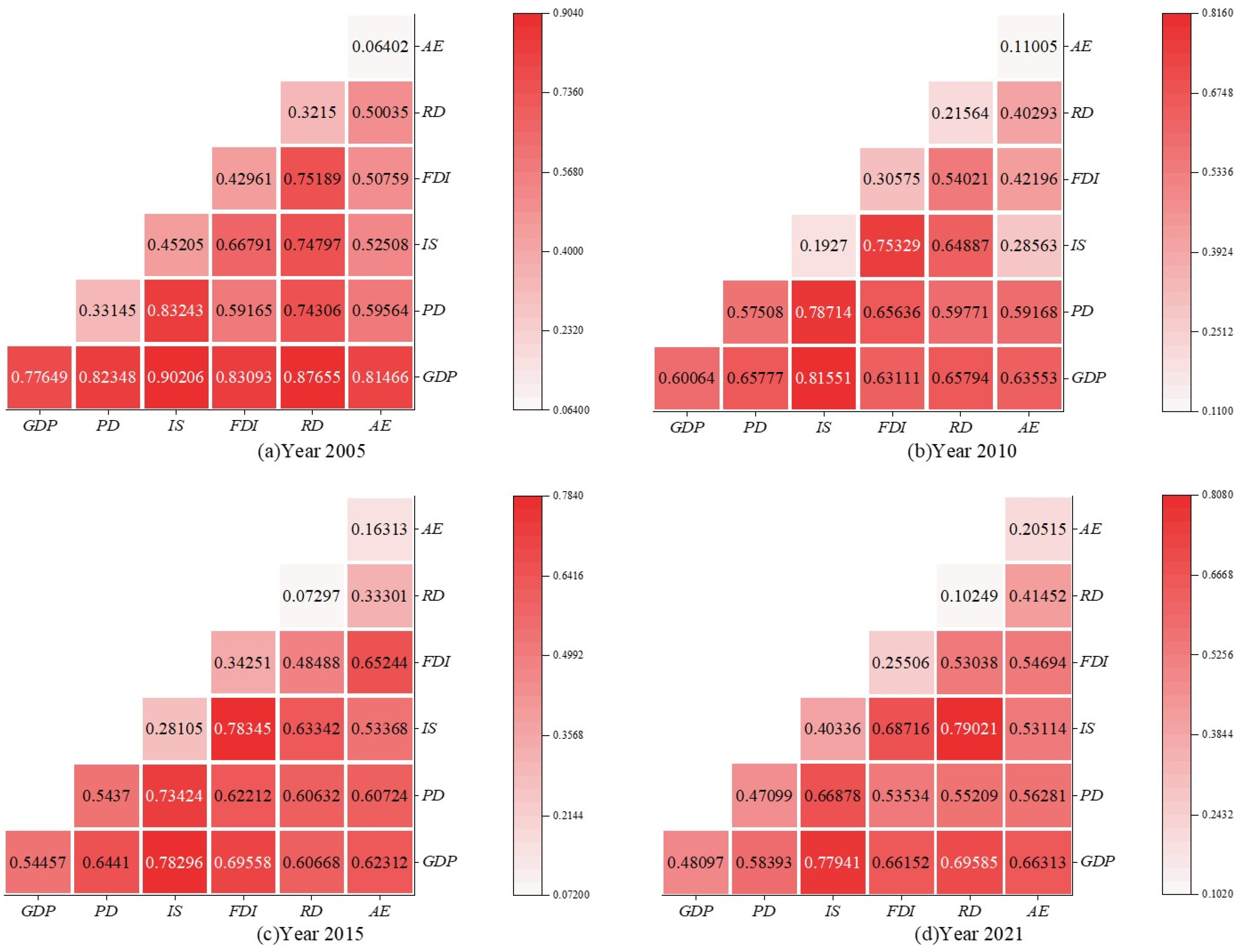Study on Spatial-Temporal Disparities and Factors Influencing Electricity Consumption Carbon Emissions in China
Abstract
:1. Introduction
2. Methodology and Data
2.1. Calculation of ECCE
2.2. Natural Breakpoint Method
2.3. Dagum Gini Coefficient
2.4. Geodetector
2.5. Selection of Impact Indicators
2.6. Data Sources and Processing
3. Results and Analysis
3.1. Characteristics of Spatial Differentiation
3.2. Regional Disparities and Their Decomposition
3.3. Factors Influencing Spatial Differentiation in ECCEs in China
3.3.1. Analysis of Factor Detection Results
3.3.2. Interaction of Factors
4. Discussion
- (1)
- This paper measured ECCEs in provincial areas, which are relatively large in scale, and the conclusions and policy recommendations are weakly applicable in city and county areas. However, considering the availability of data, this paper still adopted provincial data for its study, and, in future studies, it could dig deeper into the data of cities and even counties to conduct more detailed research.
- (2)
- There are many factors affecting the spatial differentiation in the carbon emissions from China’s electric power consumption, and this paper only selected six influencing factors to analyze the factors influencing the carbon emissions from China’s electric power consumption. In future research, we can consider introducing more quantifiable and reliable potential influencing factors into the Geodetector model for research and analysis to provide more ideas for formulating China’s electric power low-carbon development policy.
- (3)
- This paper detected influencing factors such as economic development and population density in each province of China. However, the specific correlation between the ECCE and the influencing factors is not yet clear, and other models have to be applied to explore this in subsequent studies.
5. Conclusions
- (1)
- The ECCEs at the provincial level in China showed significant spatial differentiation across the four study years. The Shandong, Hebei, Jiangsu, and Guangdong provinces were high-value carbon emission zones, and Qinghai and Hainan provinces were low-value carbon emission zones. Xinjiang and Inner Mongolia gradually became higher-value or high-value carbon emission areas.
- (2)
- The overall difference in the ECCEs among China’s three major regions increased during the study period. Disparities in the ECCEs were most significant among the provinces in the eastern region, followed by the central region, and they were smallest in the western region. The most significant disparities were found between the eastern and western regions, followed by those between the eastern and central regions, and the smallest were between the central and western regions. The inter-regional disparities in the carbon emissions from China’s electricity consumption were the largest source of overall disparities.
- (3)
- Economic development, population density, industrialization, and foreign direct investment (FDI) strongly influenced the spatial differentiation in the carbon emissions from China’s electricity consumption over the four study years. In addition, after the interaction of each influencing factor, the influence on the spatial differentiation in the carbon emissions from China’s electricity consumption was more significant than that of a single influencing factor. It is worth noting that economic development had the most significant impact as the key influencing factor in all four study years. Industrialization had an essential influence on the spatial differentiation in the ECCE in China after interacting with other influencing factors.
6. Policy Recommendations
- (1)
- In promoting the process of reducing carbon emissions from the consumption side of electricity, the Chinese government should adhere to the leading role of narrowing the gap in the ECCEs among provinces and regions, promoting coordination and cooperation among regional governments, promoting cross-regional technology exchange and experience sharing, and accelerating the popularization and application of renewable energy power generation and energy efficiency technologies throughout the country. Local governments can encourage local power companies to increase the share of renewable energy in power generation by formulating relevant energy policies, such as increasing renewable energy subsidies and carbon emission standards, to reduce carbon emissions at the source [57]. At the same time, each province should consider its carbon emission situation and regional development characteristics and choose a low-carbon emission reduction model that suits the development reality and reflects the regional characteristics according to local conditions.
- (2)
- Chinese provinces, especially Shandong, Jiangsu, Guangdong, and Hebei, that have high carbon emission levels from electricity consumption need to reconcile population density, industrialization, foreign direct investment, and economic development. If the existing energy consumption structure remains stable for a long time, we should gradually change the crude economic development mode of high energy consumption and high emission, improve energy efficiency and reduce energy consumption at the same time, promote the agglomeration of capital, talents, technology, and other factors by urbanization, promote the transformation and upgrading of industry from resource-intensive to technology-intensive, actively develop the tertiary industry, and increase the absorption capacity of high-quality, high-technology, low-pollution, low-energy consumption green FDI to promote the progress of energy-saving technology and the upgrading of our industrial structure. This would reduce the ECCE while systematically optimizing population density, industrialization, foreign direct investment, and economic development.
Author Contributions
Funding
Institutional Review Board Statement
Informed Consent Statement
Data Availability Statement
Conflicts of Interest
References
- Mathew, M.D. Nuclear energy: A pathway towards mitigation of global warming. Prog. Nucl. Energy 2022, 143, 104080. [Google Scholar] [CrossRef]
- Raihan, A.; Ibrahim, S.; Muhtasim, D.A. Dynamic impacts of economic growth, energy use, tourism, and agricultural productivity on carbon dioxide emissions in Egypt. World Dev. Sustain. 2023, 2, 100059. [Google Scholar] [CrossRef]
- Raihan, A. An econometric evaluation of the effects of economic growth, energy use, and agricultural value added on carbon dioxide emissions in Vietnam. Asia-Pac. J. Reg. Sci. 2023, 7, 665–696. [Google Scholar] [CrossRef]
- Gao, P.; Yue, S.; Chen, H. Carbon emission efficiency of China’s industry sectors: From the perspective of embodied carbon emissions. J. Clean. Prod. 2021, 283, 124655. [Google Scholar] [CrossRef]
- Gür, T.M. Carbon dioxide emissions, capture, storage and utilization: Review of materials, processes and technologies. Prog. Energy Combust. Sci. 2022, 89, 100965. [Google Scholar]
- Teng, F.; Wang, P. The evolution of climate governance in China: Drivers, features, and effectiveness. Environ. Politics 2021, 30 (Suppl. S1), 141–161. [Google Scholar] [CrossRef]
- Yang, P.; Peng, S.; Benani, N.; Dong, L.; Li, X.; Liu, R.; Mao, G. An integrated evaluation on China’s provincial carbon peak and carbon neutrality. J. Clean. Prod. 2022, 377, 134497. [Google Scholar] [CrossRef]
- Wei, Y.M.; Chen, K.; Kang, J.N.; Chen, W.; Wang, X.Y.; Zhang, X. Policy and management of carbon peaking and carbon neutrality: A literature review. Engineering 2022, 14, 52–63. [Google Scholar] [CrossRef]
- Wang, Y.; Chen, H.; Long, R.; Sun, Q.; Jiang, S.; Liu, B. Has the sustainable development planning policy promoted the green transformation in China’s resource-based cities? Resour. Conserv. Recycl. 2022, 180, 106181. [Google Scholar] [CrossRef]
- Xie, P.; Shu, Y.; Sun, F.; Pan, X. Enhancing the accuracy of China’s electricity consumption forecasting through economic cycle division: An MSAR-OPLS scenario analysis. Energy 2024, 293, 130618. [Google Scholar] [CrossRef]
- Fang, T.; Fang, D.; Yu, B. Carbon emission efficiency of thermal power generation in China: Empirical evidence from the micro-perspective of power plants. Energy Policy 2022, 165, 112955. [Google Scholar] [CrossRef]
- Wei, W.; Zhang, P.; Yao, M.; Xue, M.; Miao, J.; Liu, B.; Wang, F. Multi-scope electricity-related carbon emissions accounting: A case study of Shanghai. J. Clean. Prod. 2020, 252, 119789. [Google Scholar] [CrossRef]
- Cai, L.; Duan, J.; Lu, X.; Luo, J.; Yi, B.; Wang, Y.; Wang, L. Pathways for electric power industry to achieve carbon emissions peak and carbon neutrality based on LEAP model: A case study of state-owned power generation enterprise in China. Comput. Ind. Eng. 2022, 170, 108334. [Google Scholar] [CrossRef]
- Fan, F.; Wang, Y.; Liu, Q. China’s carbon emissions from the electricity sector: Spatial characteristics and interregional transfer. Integr. Environ. Assess. Manag. 2022, 18, 258–273. [Google Scholar] [CrossRef] [PubMed]
- Xie, P.; Yang, F.; Mu, Z.; Gao, S. Influencing factors of the decoupling relationship between CO2 emission and economic development in China’s power industry. Energy 2020, 209, 118341. [Google Scholar] [CrossRef]
- Wang, J.; Li, Z.; Wu, T.; Wu, S.; Yin, T. The decoupling analysis of CO2 emissions from power generation in Chinese provincial power sector. Energy 2022, 255, 124488. [Google Scholar] [CrossRef]
- Li, W.; Long, R.; Zhang, L.; He, Z.; Chen, F.; Chen, H. Greenhouse gas emission transfer of inter-provincial electricity trade in china. Int. J. Environ. Res. Public Health 2020, 17, 8375. [Google Scholar] [CrossRef]
- Zhang, P.; Cai, W.; Yao, M.; Wang, Z.; Yang, L.; Wei, W. Urban carbon emissions associated with electricity consumption in Beijing and the driving factors. Appl. Energy 2020, 275, 115425. [Google Scholar] [CrossRef]
- Scarlat, N.; Prussi, M.; Padella, M. Quantification of the carbon intensity of electricity produced and used in Europe. Appl. Energy 2022, 305, 1179. [Google Scholar] [CrossRef]
- Chen, L.; Xu, L.; Xia, L.; Wang, Y.; Yang, Z. Decomposition of residential electricity-related CO2 emissions in China, a spatial-temporal study. J. Environ. Manag. 2022, 320, 115754. [Google Scholar] [CrossRef]
- Li, Y.; Yang, X.; Du, E.; Liu, Y.; Zhang, S.; Yang, C.; Liu, C. A review on carbon emission accounting approaches for the electricity power industry. Appl. Energy 2024, 359, 122681. [Google Scholar] [CrossRef]
- He, Y.; Xing, Y.; Zeng, X.; Ji, Y.; Hou, H.; Zhang, Y.; Zhu, Z. Factors influencing carbon emissions from China’s electricity industry: Analysis using the combination of LMDI and K-means clustering. Environ. Impact Assess. Rev. 2022, 93, 106724. [Google Scholar] [CrossRef]
- Karmellos, M.; Kosmadakis, V.; Dimas, P.; Tsakanikas, A.; Fylaktos, N.; Taliotis, C.; Zachariadis, T. A decomposition and decoupling analysis of carbon dioxide emissions from electricity generation: Evidence from the EU-27 and the UK. Energy 2021, 231, 120861. [Google Scholar] [CrossRef]
- Noorpoor, A.R.; Kudahi, S.N. CO2 emissions from Iran’s power sector and analysis of the influencing factors using the stochastic impacts by regression on population, affluence and technology (STIRPAT) model. Carbon Manag. 2015, 6, 101–116. [Google Scholar] [CrossRef]
- Cui, H.; Zhao, T.; Wu, R. CO2 emissions from China’s power industry: Policy implications from both macro and micro perspectives. J. Clean. Prod. 2018, 200, 746–755. [Google Scholar] [CrossRef]
- Wen, L.; Yan, F. Regional differences and influencing factors in the CO2 emissions of China’s power industry based on the panel data models considering power-consuming efficiency factor. Environ. Dev. Sustain. 2018, 20, 1987–2007. [Google Scholar] [CrossRef]
- Wang, X.; Li, M. The spatiotemporal characteristic of carbon emissions from China’s power sector and its determinants: A spatial econometric analysis. Pol. J. Environ. Stud. 2019, 28, 3919–3927. [Google Scholar] [CrossRef] [PubMed]
- Sun, X.; Lian, W.; Gao, T.; Chen, Z.; Duan, H. Spatial-temporal characteristics of carbon emission intensity in electricity generation and spatial spillover effects of driving factors across China’s provinces. J. Clean. Prod. 2023, 405, 136908. [Google Scholar] [CrossRef]
- Lian, Y.; Lin, X.; Luo, H.; Zhang, J.; Sun, X. Distribution characteristics and influencing factors of household consumption carbon emissions in China from a spatial perspective. J. Environ. Manag. 2024, 351, 119564. [Google Scholar] [CrossRef]
- Liu, J.; Li, S.; Ji, Q. Regional differences and driving factors analysis of carbon emission intensity from transport sector in China. Energy 2021, 224, 120178. [Google Scholar] [CrossRef]
- Wang, G.; Liao, M.; Jiang, J. Research on agricultural carbon emissions and regional carbon emissions reduction strategies in China. Sustainability 2020, 12, 2627. [Google Scholar] [CrossRef]
- Ma, T.; Liu, Y.; Yang, M. Spatial-temporal heterogeneity for commercial building carbon emissions in China: Based the Dagum Gini Coefficient. Sustainability 2022, 14, 5243. [Google Scholar] [CrossRef]
- Wang, L.; You, J. An integrated perspective on the spatial–temporal characteristics of China’s manufacturing carbon emissions at the regional and industry levels. Energy Rep. 2023, 10, 1688–1701. [Google Scholar] [CrossRef]
- Xu, L.; Du, H.; Zhang, X. Driving forces of carbon dioxide emissions in China’s cities: An empirical analysis based on the geodetector method. J. Clean. Prod. 2021, 287, 125169. [Google Scholar] [CrossRef]
- Zhu, C.; Dong, S.; Sun, Y.; Wang, M.; Dong, P.; Xu, L. Driving factors of spatial–temporal difference in China’s transportation sector carbon productivity: An empirical analysis based on Geodetector method. Environ. Sci. Pollut. Res. 2023, 30, 30656–30671. [Google Scholar] [CrossRef] [PubMed]
- Wang, J.F.; Xu, C.D. Geodetector: Principle and prospective. Acta Geogr. Sin. 2017, 72, 116–134. [Google Scholar]
- Chen, C.; Bi, L. Study on spatio-temporal changes and driving factors of carbon emissions at the building operation stage—A case study of China. Build. Environ. 2022, 219, 109147. [Google Scholar] [CrossRef]
- Guo, Q.; Lai, X.; Jia, Y.; Wei, F. Spatiotemporal Pattern and Driving Factors of Carbon Emissions in Guangxi Based on Geographic Detectors. Sustainability 2023, 15, 15477. [Google Scholar] [CrossRef]
- Wang, K.L.; Xu, R.Y.; Zhang, F.Q.; Cheng, Y.H. Reinvestigating the spatiotemporal differences and driving factors of urban carbon emission in China. Front. Environ. Sci. 2022, 10, 880527. [Google Scholar] [CrossRef]
- Xu, J. Study on spatiotemporal distribution characteristics and driving factors of carbon emission in Anhui Province. Sci. Rep. 2023, 13, 14400. [Google Scholar] [CrossRef]
- Xie, P.; Sun, B.; Liu, L.; Xie, Y.; Yang, F.; Zhang, R. China’s power industry’s carbon emission intensity in the context of carbon peaking and carbon neutrality: Measurement and regional difference. Int. J. Clim. Change Strateg. Manag. 2023, 15, 264–281. [Google Scholar] [CrossRef]
- Jenks, G.F. The data model concept in statistical mapping. Int. Yearb. Cartogr. 1967, 7, 186–190. [Google Scholar]
- Zhao, L.D.; Wu, D. Carbon emission accounting and spatial heterogeneity pattern of China’s energy supply side. China Popul. Resour. Environ. 2018, 28, 48–58. [Google Scholar]
- Zhang, L.; Ma, X.; Ock, Y.S.; Qing, L. Research on regional differences and influencing factors of Chinese industrial green technology innovation efficiency based on dagum gini coefficient decomposition. Land 2022, 11, 122. [Google Scholar] [CrossRef]
- Liao, C.; Wang, S.; Fang, J.; Zheng, H.; Liu, J.; Zhang, Y. Driving forces of provincial-level CO2 emissions in China’s power sector based on LMDI method. Energy Procedia 2019, 158, 3859–3864. [Google Scholar] [CrossRef]
- Yan, D.; Lei, Y.; Li, L. Driving factor analysis of carbon emissions in China’s power sector for low-carbon economy. Math. Probl. Eng. 2017, 2017, 4954217. [Google Scholar] [CrossRef]
- Wei, H.; Zhan, T.; Yi, Z.; Shuo, W.; Yan, L. A Study on the Drivers of Carbon Emissions in China’s Power Industry Based on an Improved PDA Method. Systems 2023, 11, 495. [Google Scholar] [CrossRef]
- Gao, S.; Zhang, X.; Chen, M. Spatiotemporal dynamics and driving forces of city-level CO2 emissions in China from 2000 to 2019. J. Clean. Prod. 2022, 377, 134358. [Google Scholar] [CrossRef]
- Wang, D.; Zhang, Y.; Zou, Z. How asymmetric is the response of CO2 emissions to economic restructuring in China? Evidence from NARDL approach. J. Clean. Prod. 2023, 423, 138836. [Google Scholar] [CrossRef]
- Zhu, Y.; Liu, Z.; Feng, S.; Lu, N. The role of fiscal expenditure on science and technology in carbon reduction: Evidence from provincial data in China. Environ. Sci. Pollut. Res. 2022, 29, 82030–82044. [Google Scholar] [CrossRef]
- Qi, S.; Lin, S. The influencing factors on the carbon emission of electric power industry: An empirical study based on Yangtze Economic Belt spatial dynamic panel. J. Environ. Econ. 2016, 1, 91–105. [Google Scholar]
- Cui, Y.; Wei, Z.; Xue, Q.; Sohail, S. Educational attainment and environmental Kuznets curve in China: An aggregate and disaggregate analysis. Environ. Sci. Pollut. Res. 2022, 29, 45612–45622. [Google Scholar] [CrossRef] [PubMed]
- Zhao, L.; Jia, B.; Hu, M. The Impact of Human Capital on Carbon Emission Density in Chinese Provincial Based on the Spatial Econometric Analysis. Popul. Dev. 2014, 20, 2–10. [Google Scholar]
- Shan, Y.; Guan, D.; Zheng, H.; Ou, J.; Li, Y.; Meng, J.; Zhang, Q. China CO2 emission accounts 1997–2015. Sci. Data 2018, 5, 170201. [Google Scholar] [CrossRef] [PubMed]
- Wu, X.; Xu, C.; Ma, T.; Xu, J.; Zhang, C. Carbon emission of China’s power industry: Driving factors and emission reduction path. Environ. Sci. Pollut. Res. 2022, 29, 78345–78360. [Google Scholar] [CrossRef] [PubMed]
- Yan, Q.; Wang, Y.; Baležentis, T.; Streimikiene, D. Analysis of China’s regional thermal electricity generation and CO2 emissions: Decomposition based on the generalized Divisia index. Sci. Total Environ. 2019, 682, 737–755. [Google Scholar] [CrossRef]
- Peng, Q.; Liu, W.; Zhang, Y.; Zeng, S.; Graham, B. Generation planning for power companies with hybrid production technologies under multiple renewable energy policies. Renew. Sustain. Energy Rev. 2023, 176, 113209. [Google Scholar] [CrossRef]







| Variable | Definition |
|---|---|
| Kn | Electricity generation efficiency by province in year n |
| Sn | Efficiency of electricity use in each province in year n |
| ECV | Equivalent value of electricity, generally taken as 0.1229 kgcc/kWh |
| EEVn | Equivalent value of electricity in each province in year n |
| FCk,n | Consumption of fossil fuel k in thermal power generation by province in year n |
| Rk | Conversion standard coal factor for fossil fuel k |
| TPn | Thermal power generation by province in year n |
| GDPn | Gross domestic product (GDP) of provinces in year n |
| YPn | Electricity consumption by province in year n |
| Bn | Maximum value of GDPn/YPn among 30 provinces in year n |
| Variable | Definition |
|---|---|
| EFICni | Carbon emission factor for electricity consumption in province i in year n |
| GEni | Total electricity generation in province i in year n |
| EOni | Total electricity transferred from province i for consumption in other provinces in year n |
| (GEni − EOni) | Total electricity consumption in province i in year n |
| θni | Share of ECCEs in direct carbon emissions from electricity in province i in year n |
| Pni | Direct carbon emissions from electricity generation in province i in year n |
| ∑g≠iGEng | Total electricity generation in provinces other than province i |
| ERni | Total electricity transferred from other provinces for consumption in province i in year n |
| Basis of Judgment | Interaction |
|---|---|
| q(X1∩X2) < Min(q(X1), q(X2)) | Nonlinear weakening |
| Min(q(X1), q(X2)) < q(X1∩X2) < Max(q(X1), q(X2)) | One-factor nonlinear enhancement |
| q(X1∩X2) > Max(q(X1), q(X2)) | Two-factor enhancement |
| q(X1∩X2) = q(X1) + q(X2) | Standalone |
| q(X1∩X2) > q(X1) + q(X)2 | Nonlinear enhancement |
Disclaimer/Publisher’s Note: The statements, opinions and data contained in all publications are solely those of the individual author(s) and contributor(s) and not of MDPI and/or the editor(s). MDPI and/or the editor(s) disclaim responsibility for any injury to people or property resulting from any ideas, methods, instructions or products referred to in the content. |
© 2024 by the authors. Licensee MDPI, Basel, Switzerland. This article is an open access article distributed under the terms and conditions of the Creative Commons Attribution (CC BY) license (https://creativecommons.org/licenses/by/4.0/).
Share and Cite
Xie, P.; Wang, S.; Liao, J.; Sun, F. Study on Spatial-Temporal Disparities and Factors Influencing Electricity Consumption Carbon Emissions in China. Sustainability 2024, 16, 4128. https://doi.org/10.3390/su16104128
Xie P, Wang S, Liao J, Sun F. Study on Spatial-Temporal Disparities and Factors Influencing Electricity Consumption Carbon Emissions in China. Sustainability. 2024; 16(10):4128. https://doi.org/10.3390/su16104128
Chicago/Turabian StyleXie, Pinjie, Sheng Wang, Jie Liao, and Feihu Sun. 2024. "Study on Spatial-Temporal Disparities and Factors Influencing Electricity Consumption Carbon Emissions in China" Sustainability 16, no. 10: 4128. https://doi.org/10.3390/su16104128
APA StyleXie, P., Wang, S., Liao, J., & Sun, F. (2024). Study on Spatial-Temporal Disparities and Factors Influencing Electricity Consumption Carbon Emissions in China. Sustainability, 16(10), 4128. https://doi.org/10.3390/su16104128








